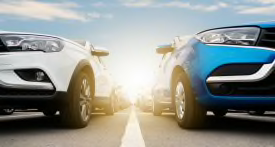New midsized model is key for this emerging electric brand
The Polestar 3 SUV will expand Volvo’s electric-only sub-brand’s portfolio in 2024, when it joins the 2 hatchback. This midsized model will compete directly with the recently introduced Mercedes-Benz EQE SUV, as well as the Audi Q8 E-Tron, BMW iX, Cadillac Lyriq, and other upcoming luxe SUV EVs.
The design and packaging reflect the Scandinavian pedigree, with restrained styling, an emphasis on safety and sustainability, and premium audio—all hallmarks of the related Volvo brand. Both Polestar and Volvo are primarily owned by the Chinese corporation Zhejiang Geely Holding Group (ZGH), and Polestar is now a publicly traded company.
Key to the 3’s positioning is its premium standard equipment. Notably, it has a long roster of active driver assistance features, aided by five radars, five external cameras, and 12 ultrasonic sensors. Plus it will be available with lidar and even more sensors as a precursor to autonomous driving.
Based on a new electric platform shared with Volvo, the Polestar 3 will be produced initially in China. Production for the U.S. market will shift to Volvo’s Ridgeville, S.C., factory in 2024. This will allow the 3 to then be eligible for full federal tax credits under the new rules. It was originally thought to be a 2024 model, but it is now expected to be a 2025.
The Polestar 3 Launch Edition is planned to arrive at dealers in summer 2024, with other versions to follow in the fall.
It will be followed by the Polestar 4, a smaller electric performance SUV coupe. The Polestar 5 electric performance four-door GT sedan is planned.
The 3 competes with the Audi Q8 E-Tron, BMW iX, Cadillac Lyriq, Mercedes-Benz EQE SUV, and Tesla Model X.

















